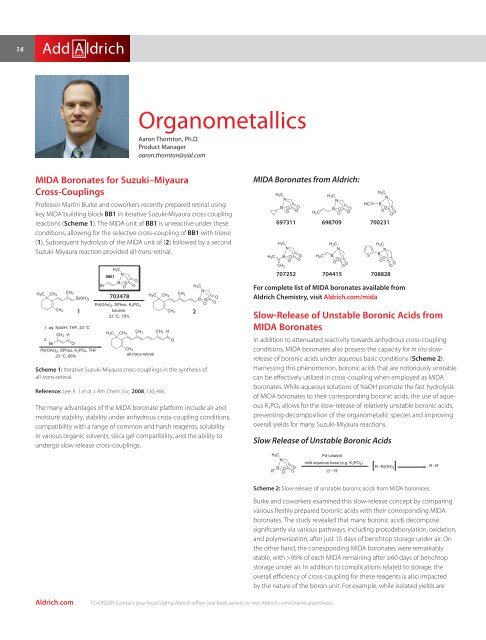Missing out on the latest research developments in ... - Sigma-Aldrich
Missing out on the latest research developments in ... - Sigma-Aldrich
Missing out on the latest research developments in ... - Sigma-Aldrich
You also want an ePaper? Increase the reach of your titles
YUMPU automatically turns print PDFs into web optimized ePapers that Google loves.
14<br />
MIDA Bor<strong>on</strong>ates for Suzuki–Miyaura<br />
Cross-Coupl<strong>in</strong>gs<br />
<strong>Aldrich</strong>.com<br />
Organometallics<br />
Aar<strong>on</strong> Thornt<strong>on</strong>, Ph.D.<br />
Product Manager<br />
aar<strong>on</strong>.thornt<strong>on</strong>@sial.com<br />
Professor Mart<strong>in</strong> Burke and coworkers recently prepared ret<strong>in</strong>al us<strong>in</strong>g<br />
key MIDA build<strong>in</strong>g block BB1 <strong>in</strong> iterative Suzuki-Miyaura cross coupl<strong>in</strong>g<br />
reacti<strong>on</strong>s (Scheme 1). The MIDA unit of BB1 is unreactive under <strong>the</strong>se<br />
c<strong>on</strong>diti<strong>on</strong>s, allow<strong>in</strong>g for <strong>the</strong> selective cross-coupl<strong>in</strong>g of BB1 with triene<br />
(1). Subsequent hydrolysis of <strong>the</strong> MIDA unit of (2) followed by a sec<strong>on</strong>d<br />
Suzuki-Miyaura reacti<strong>on</strong> provided all-trans-ret<strong>in</strong>al.<br />
H3C<br />
CH3<br />
CH3<br />
B(OH)2<br />
H3C N<br />
BB1<br />
O<br />
B O<br />
Br O O<br />
703478<br />
Pd(OAc)2, SPhos, K3PO4<br />
H3C CH3<br />
CH3<br />
H3C<br />
N<br />
B O<br />
O<br />
O<br />
O<br />
CH3 1 toluene<br />
23 °C, 78%<br />
CH3 2<br />
1. aq. NaOH, THF, 23 °C<br />
CH3 H<br />
2.<br />
Br O<br />
Pd(OAc)2, SPhos, K3PO4, THF<br />
23 °C, 66%<br />
CH3 CH3 H3C<br />
H<br />
CH3<br />
O<br />
CH3<br />
all-trans-ret<strong>in</strong>al<br />
Scheme 1: Iterative Suzuki-Miyaura cross-coupl<strong>in</strong>gs <strong>in</strong> <strong>the</strong> syn<strong>the</strong>sis of<br />
all-trans-ret<strong>in</strong>al.<br />
Reference: Lee, S. J. et al. J. Am. Chem. Soc. 2008, 130, 466.<br />
The many advantages of <strong>the</strong> MIDA bor<strong>on</strong>ate platform <strong>in</strong>clude air and<br />
moisture stability, stability under anhydrous cross-coupl<strong>in</strong>g c<strong>on</strong>diti<strong>on</strong>s,<br />
compatibility with a range of comm<strong>on</strong> and harsh reagents, solubility<br />
<strong>in</strong> various organic solvents, silica gel compatibility, and <strong>the</strong> ability to<br />
undergo slow release cross-coupl<strong>in</strong>gs.<br />
MIDA Bor<strong>on</strong>ates from <strong>Aldrich</strong>:<br />
H3C<br />
N<br />
B O O<br />
O O<br />
697311<br />
H3C<br />
H3C<br />
N<br />
B O<br />
O<br />
CH2 O<br />
O<br />
707252<br />
TO ORDER: C<strong>on</strong>tact your local <strong>Sigma</strong>-<strong>Aldrich</strong> offi ce (see back cover), or visit <strong>Aldrich</strong>.com/chemicalsyn<strong>the</strong>sis.<br />
H2C<br />
H2C<br />
H3C<br />
N<br />
B O O<br />
O O<br />
N<br />
B<br />
O<br />
O<br />
O O<br />
H3C<br />
698709 700231<br />
N<br />
B<br />
O<br />
O<br />
O O<br />
H3C<br />
704415<br />
HC<br />
S<br />
N<br />
B<br />
O<br />
O<br />
O O<br />
H3C<br />
708828<br />
For complete list of MIDA bor<strong>on</strong>ates available from<br />
<strong>Aldrich</strong> Chemistry, visit <strong>Aldrich</strong>.com/mida<br />
Slow-Release of Unstable Bor<strong>on</strong>ic Acids from<br />
MIDA Bor<strong>on</strong>ates<br />
In additi<strong>on</strong> to attenuated reactivity towards anhydrous cross-coupl<strong>in</strong>g<br />
c<strong>on</strong>diti<strong>on</strong>s, MIDA bor<strong>on</strong>ates also possess <strong>the</strong> capacity for <strong>in</strong> situ slowrelease<br />
of bor<strong>on</strong>ic acids under aqueous basic c<strong>on</strong>diti<strong>on</strong>s (Scheme 2).<br />
Harness<strong>in</strong>g this phenomen<strong>on</strong>, bor<strong>on</strong>ic acids that are notoriously unstable<br />
can be eff ectively utilized <strong>in</strong> cross-coupl<strong>in</strong>g when employed as MIDA<br />
bor<strong>on</strong>ates. While aqueous soluti<strong>on</strong>s of NaOH promote <strong>the</strong> fast hydrolysis<br />
of MIDA bor<strong>on</strong>ates to <strong>the</strong>ir corresp<strong>on</strong>d<strong>in</strong>g bor<strong>on</strong>ic acids, <strong>the</strong> use of aqueous<br />
K3PO4 allows for <strong>the</strong> slow-release of relatively unstable bor<strong>on</strong>ic acids,<br />
prevent<strong>in</strong>g decompositi<strong>on</strong> of <strong>the</strong> organometallic species and improv<strong>in</strong>g<br />
overall yields for many Suzuki-Miyaura reacti<strong>on</strong>s.<br />
Slow Release of Unstable Bor<strong>on</strong>ic Acids<br />
R B<br />
H3C<br />
Pd-catalyst<br />
N<br />
O<br />
O<br />
O<br />
O<br />
mild aqueous base (e.g. K3PO4)<br />
Cl R'<br />
R B(OH)2<br />
Scheme 2: Slow-release of unstable bor<strong>on</strong>ic acids from MIDA bor<strong>on</strong>ates.<br />
Burke and coworkers exam<strong>in</strong>ed this slow-release c<strong>on</strong>cept by compar<strong>in</strong>g<br />
various freshly prepared bor<strong>on</strong>ic acids with <strong>the</strong>ir corresp<strong>on</strong>d<strong>in</strong>g MIDA<br />
bor<strong>on</strong>ates. The study revealed that many bor<strong>on</strong>ic acids decompose<br />
signifi cantly via various pathways, <strong>in</strong>clud<strong>in</strong>g protodeborylati<strong>on</strong>, oxidati<strong>on</strong>,<br />
and polymerizati<strong>on</strong>, after just 15 days of benchtop storage under air. On<br />
<strong>the</strong> o<strong>the</strong>r hand, <strong>the</strong> corresp<strong>on</strong>d<strong>in</strong>g MIDA bor<strong>on</strong>ates were remarkably<br />
stable, with >95% of each MIDA rema<strong>in</strong><strong>in</strong>g after ≥60 days of benchtop<br />
storage under air. In additi<strong>on</strong> to complicati<strong>on</strong>s related to storage, <strong>the</strong><br />
overall effi ciency of cross-coupl<strong>in</strong>g for <strong>the</strong>se reagents is also impacted<br />
by <strong>the</strong> nature of <strong>the</strong> bor<strong>on</strong> unit. For example, while isolated yields are<br />
R R'

















